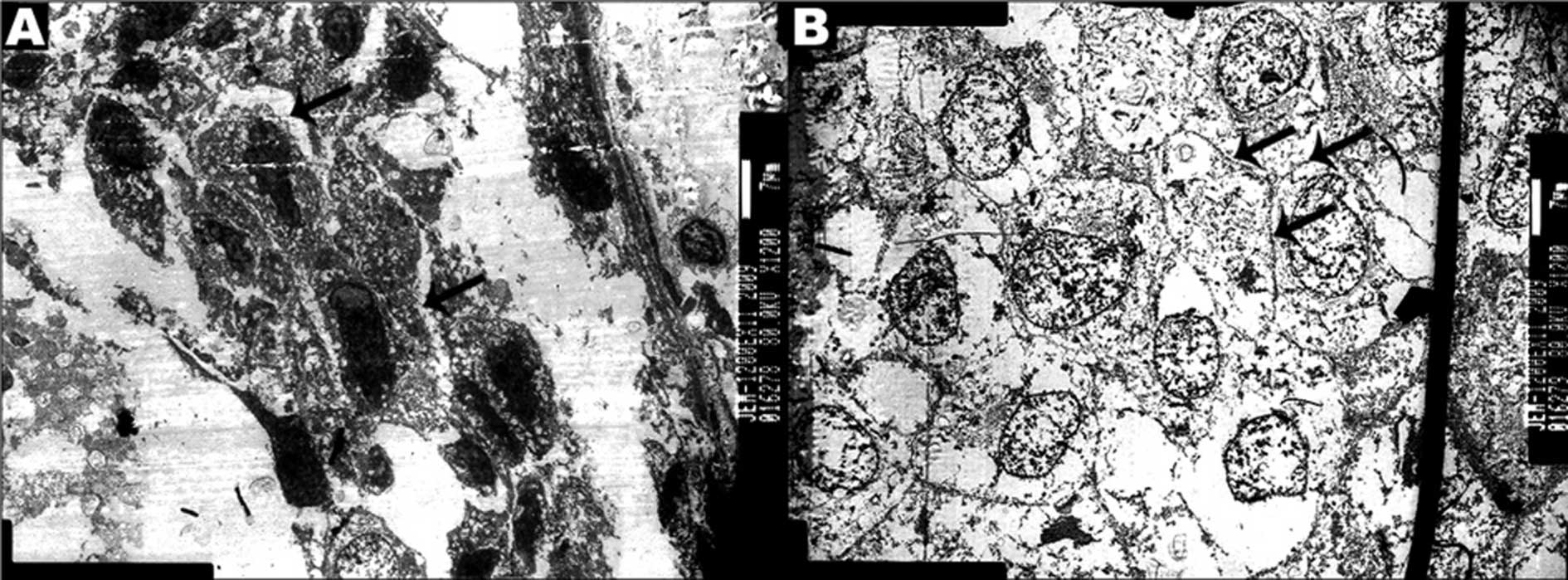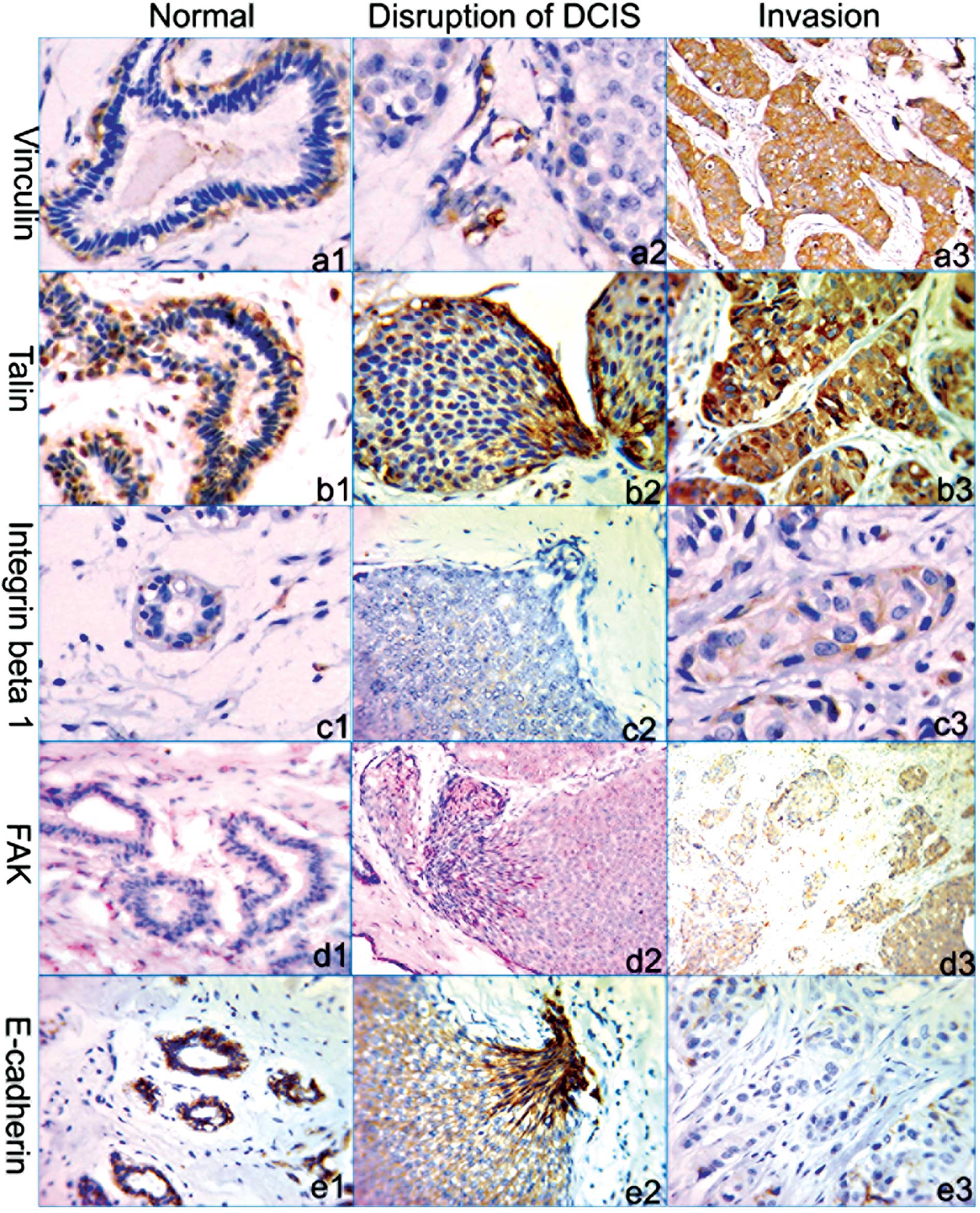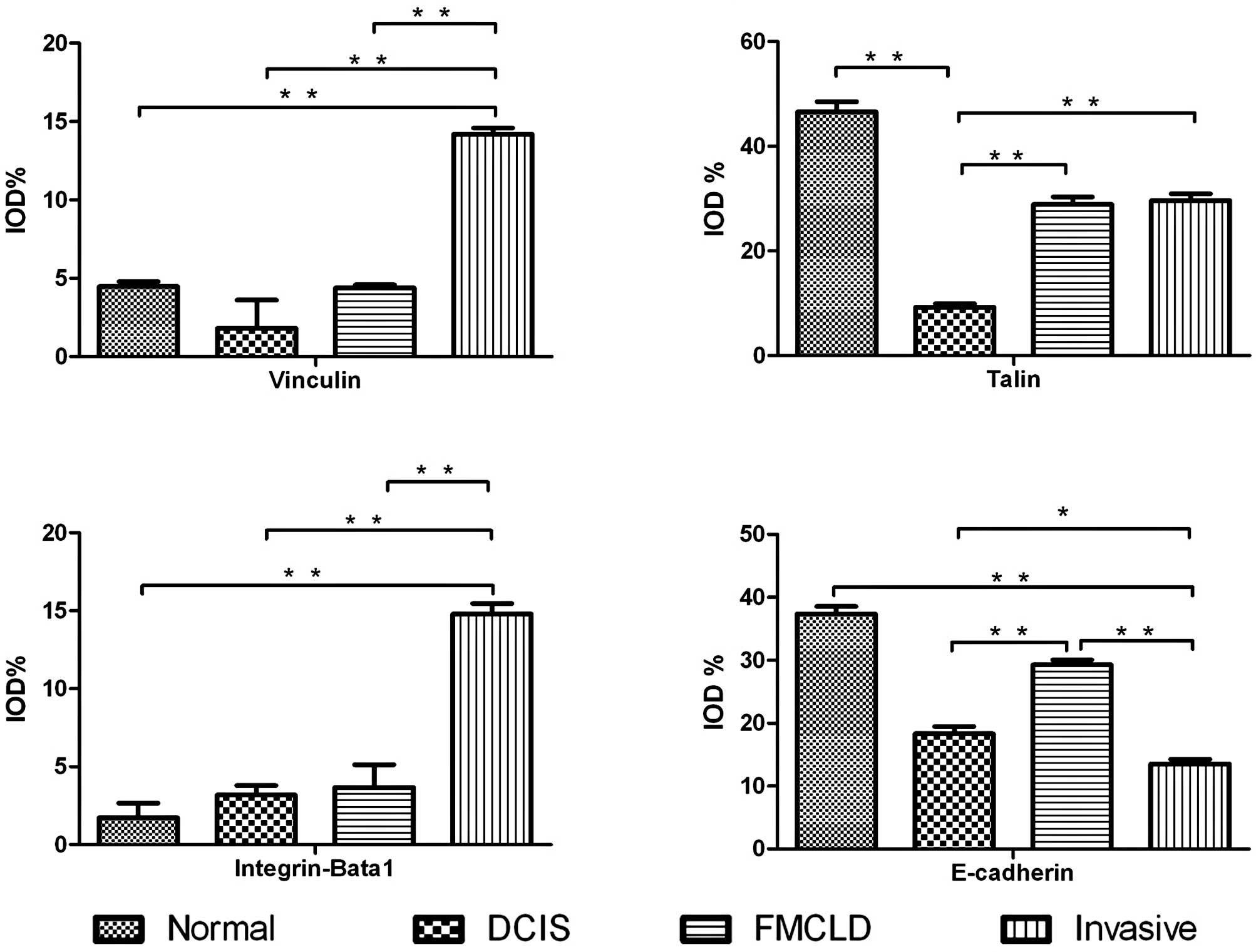|
1.
|
Beckmann MW, Niederacher D, Schnurch HG,
Gusterson BA and Bender HG: Multistep carcinogenesis of breast
cancer and tumour heterogeneity. J Mol Med. 75:429–439. 1997.
View Article : Google Scholar : PubMed/NCBI
|
|
2.
|
Schmitt FC: Multistep progression from an
oestrogen-dependent growth towards an autonomous growth in breast
carcinogenesis. Eur J Cancer. 31A:2049–2052. 1995. View Article : Google Scholar : PubMed/NCBI
|
|
3.
|
Clarke R, Brunner N, Katzenellenbogen BS,
et al: Progression of human breast cancer cells from
hormone-dependent to hormone-independent growth both in vitro and
in vivo. Proc Natl Acad Sci USA. 86:3649–3653. 1989. View Article : Google Scholar : PubMed/NCBI
|
|
4.
|
Tsubura A, Shikata N, Inui T, et al:
Immunohistochemical localization of myoepithelial cells and
basement membrane in normal, benign and malignant human breast
lesions. Virchows Arch A Pathol Anat Histopathol. 413:133–139.
1988. View Article : Google Scholar : PubMed/NCBI
|
|
5.
|
Jolicoeur F, Seemayer TA, Gabbiani G, et
al: Multifocal, nascent, and invasive myoepithelial carcinoma
(malignant myoepithelioma) of the breast: an immunohistochemical
and ultrastructural study. Int J Surg Pathol. 10:281–291. 2002.
View Article : Google Scholar
|
|
6.
|
Slade MJ, Coope RC, Gomm JJ and Coombes
RC: The human mammary gland basement membrane is integral to the
polarity of luminal epithelial cells. Exp Cell Res. 247:267–278.
1999. View Article : Google Scholar : PubMed/NCBI
|
|
7.
|
Miosge N: The ultrastructural composition
of basement membranes in vivo. Histol Histopathol. 16:1239–1248.
2001.PubMed/NCBI
|
|
8.
|
Nerlich A: Morphology of basement membrane
and associated matrix proteins in normal and pathological tissues.
Veroff Pathol. 145:1–139. 1995.(In German).
|
|
9.
|
Man YG, Tai L, Barner R, et al: Cell
clusters overlying focally disrupted mammary myoepithelial cell
layers and adjacent cells within the same duct display different
immunohistochemical and genetic features: implications for tumor
progression and invasion. Breast Cancer Res. 5:R231–R241. 2003.
View Article : Google Scholar
|
|
10.
|
Yousefi M, Mattu R, Gao C and Man YG:
Mammary ducts with and without focal myoepithelial cell layer
disruptions show a different frequency of white blood cell
infiltration and growth pattern: implications for tumor progression
and invasion. Appl Immunohistochem Mol Morphol. 13:30–37. 2005.
View Article : Google Scholar
|
|
11.
|
Man YG, Zhang Y, Shen T, et al: cDNA
expression profiling reveals elevated gene expression in cell
clusters overlying focally disrupted myoepithelial cell layers:
implications for breast tumor invasion. Breast Cancer Res Treat.
89:199–208. 2005. View Article : Google Scholar
|
|
12.
|
Man YG, Zhao CQ and Wang J: Breast tumor
cell clusters and their budding derivatives show different
immunohistochemical profiles during stromal invasion: implications
for hormonal and drug therapies. Cancer Ther. 4:193–204. 2006.
|
|
13.
|
Zhang X, Hashemi SS, Yousefi M, et al:
Aberrant c-erbB2 expression in cell clusters overlying focally
disrupted breast myoepithelial cell layers: a trigger or sign for
emergence of more aggressive cell clones? Int J Biol Sci.
4:259–269. 2008. View Article : Google Scholar : PubMed/NCBI
|
|
14.
|
Banyard J and Zetter BR: The role of cell
motility in prostate cancer. Cancer Metastasis Rev. 17:449–458.
1998. View Article : Google Scholar : PubMed/NCBI
|
|
15.
|
Yam JW, Tse EY and Ng IO: Role and
significance of focal adhesion proteins in hepatocellular
carcinoma. J Gastroenterol Hepatol. 24:520–530. 2009. View Article : Google Scholar : PubMed/NCBI
|
|
16.
|
Albiges-Rizo C, Destaing O, Fourcade B,
Planus E and Block MR: Actin machinery and mechanosensitivity in
invadopodia, podosomes and focal adhesions. J Cell Sci.
122:3037–3049. 2009. View Article : Google Scholar : PubMed/NCBI
|
|
17.
|
Man YG and Tavassoli FA: A simple epitope
retrieval method without the use of microwave oven or enzyme
digestion. Appl Immunohistochem. 4:139–141. 1996.
|
|
18.
|
Friedl P and Brocker EB: The biology of
cell locomotion within three-dimensional extracellular matrix. Cell
Mol Life Sci. 57:41–64. 2000. View Article : Google Scholar : PubMed/NCBI
|
|
19.
|
Mseka T, Coughlin M and Cramer LP: Graded
actin filament polarity is the organization of oriented actomyosin
II filament bundles required for fibroblast polarization. Cell
Motil Cytoskeleton. 66:743–753. 2009. View
Article : Google Scholar
|
|
20.
|
Popow-Wozniak A, Nowak D and
Malicka-Blaszkiewicz M: [Types of tumor cells movement]. Postepy
Biochem. 55:113–120. 2009.
|
|
21.
|
Friedl P and Wolf K: Tumour-cell invasion
and migration: diversity and escape mechanisms. Nat Rev Cancer.
3:362–374. 2003. View
Article : Google Scholar : PubMed/NCBI
|
|
22.
|
Pitts WC, Rojas VA, Gaffey MJ, et al:
Carcinomas with metaplasia and sarcomas of the breast. Am J Clin
Pathol. 95:623–632. 1991.PubMed/NCBI
|
|
23.
|
Klinowska TC, Soriano JV, Edwards GM, et
al: Laminin and beta1 integrins are crucial for normal mammary
gland development in the mouse. Dev Biol. 215:13–32. 1999.
View Article : Google Scholar : PubMed/NCBI
|
|
24.
|
Simian M, Hirai Y, Navre M, Werb Z,
Lochter A and Bissell MJ: The interplay of matrix
metalloproteinases, morphogens and growth factors is necessary for
branching of mammary epithelial cells. Development. 128:3117–3131.
2001.PubMed/NCBI
|
|
25.
|
Glukhova M, Koteliansky V, Sastre X and
Thiery JP: Adhesion systems in normal breast and in invasive breast
carcinoma. Am J Pathol. 146:706–716. 1995.PubMed/NCBI
|
|
26.
|
Coopman PJ, Thomas DM, Gehlsen KR and
Mueller SC: Integrin alpha 3 beta 1 participates in the
phagocytosis of extracellular matrix molecules by human breast
cancer cells. Mol Biol Cell. 7:1789–1804. 1996. View Article : Google Scholar : PubMed/NCBI
|
|
27.
|
Teuliere J, Faraldo MM, Deugnier MA, et
al: Targeted activation of beta-catenin signaling in basal mammary
epithelial cells affects mammary development and leads to
hyperplasia. Development. 132:267–277. 2005. View Article : Google Scholar : PubMed/NCBI
|
|
28.
|
Mierke CT, Kollmannsberger P, Zitterbart
DP, et al: Vinculin facilitates cell invasion into
three-dimensional collagen matrices. J Biol Chem. 285:13121–13130.
2010. View Article : Google Scholar : PubMed/NCBI
|
|
29.
|
Tanentzapf G, Martin-Bermudo MD, Hicks MS
and Brown NH: Multiple factors contribute to integrin-talin
interactions in vivo. J Cell Sci. 119:1632–1644. 2006. View Article : Google Scholar : PubMed/NCBI
|
|
30.
|
Critchley DR and Gingras AR: Talin at a
glance. J Cell Sci. 121:1345–1347. 2008. View Article : Google Scholar : PubMed/NCBI
|
|
31.
|
Beckerle MC and Yeh RK: Talin: role at
sites of cell-substratum adhesion. Cell Motil Cytoskeleton.
16:7–13. 1990. View Article : Google Scholar
|
|
32.
|
Berx G and van Roy F: The
E-cadherin/catenin complex: an important gatekeeper in breast
cancer tumorigenesis and malignant progression. Breast Cancer Res.
3:289–293. 2001. View
Article : Google Scholar : PubMed/NCBI
|
|
33.
|
Le Duc Q, Shi Q, Blonk I, et al: Vinculin
potentiates E-cadherin mechanosensing and is recruited to
actin-anchored sites within adherens junctions in a myosin
II-dependent manner. J Cell Biol. 189:1107–1115. 2010.PubMed/NCBI
|
|
34.
|
Sawada K, Mitra AK, Radjabi AR, et al:
Loss of E-cadherin promotes ovarian cancer metastasis via alpha
5-integrin, which is a therapeutic target. Cancer Res.
68:2329–2339. 2008. View Article : Google Scholar : PubMed/NCBI
|
|
35.
|
Schmitz KJ, Grabellus F, Callies R, et al:
High expression of focal adhesion kinase (p125FAK) in node-negative
breast cancer is related to overexpression of HER-2/neu and
activated Akt kinase but does not predict outcome. Breast Cancer
Res. 7:R194–R203. 2005. View
Article : Google Scholar : PubMed/NCBI
|
|
36.
|
Ren XD, Kiosses WB, Sieg DJ, Otey CA,
Schlaepfer DD and Schwartz MA: Focal adhesion kinase suppresses Rho
activity to promote focal adhesion turnover. J Cell Sci.
113:3673–3678. 2000.PubMed/NCBI
|
|
37.
|
Lark AL, Livasy CA, Dressler L, et al:
High focal adhesion kinase expression in invasive breast carcinomas
is associated with an aggressive phenotype. Mod Pathol.
18:1289–1294. 2005. View Article : Google Scholar : PubMed/NCBI
|

















